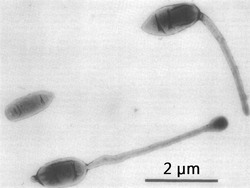Biology:Hyphomicrobiaceae
From HandWiki
Short description: Family of bacteria
| Hyphomicrobiaceae | |
|---|---|

| |
| Three representative cell types of a culture of Hyphomicrobium sp.. Note short processes on two of the three cells, thought to be remnants of the former mother hypha | |
| Scientific classification | |
| Domain: | |
| Phylum: | |
| Class: | |
| Order: | |
| Family: | Hyphomicrobiaceae Babudieri 1950
|
| Genera[3][4] | |
| |
| Synonyms | |
The Hyphomicrobiaceae are a family of bacteria. Among others, they include Rhodomicrobium, a genus of purple bacteria.
Phylogeny
The currently accepted taxonomy is based on the List of Prokaryotic names with Standing in Nomenclature (LPSN).[3] The phylogeny is based on whole-genome analysis.[4]
| |||||||||||||||||||||||||||||||||||||
References
- ↑ "Methyloceanibacter caenitepidi gen. nov., sp. nov., a facultatively methylotrophic bacterium isolated from marine sediments near a hydrothermal vent". Int J Syst Evol Microbiol 64 (Pt 2): 462–468. 2014. doi:10.1099/ijs.0.053397-0. PMID 24096357.
- ↑ "Methyloligella halotolerans gen. nov., sp. nov. and Methyloligella solikamskensis sp. nov., two non-pigmented halotolerant obligately methylotrophic bacteria isolated from the Ural saline environments". Syst Appl Microbiol 36 (3): 148–154. 2013. doi:10.1016/j.syapm.2012.12.001. PMID 23351489.
- ↑ 3.0 3.1 "Hyphomicrobiaceae". List of Prokaryotic names with Standing in Nomenclature (LPSN). https://lpsn.dsmz.de/family/hyphomicrobiaceae.
- ↑ 4.0 4.1 "Analysis of 1,000+ Type-Strain Genomes Substantially Improves Taxonomic Classification of Alphaproteobacteria". Front. Microbiol. 11: 468. 2020. doi:10.3389/fmicb.2020.00468. PMID 32373076.
- ↑ 5.0 5.1 "Uniting the classification of cultured and uncultured bacteria and archaea using 16S rRNA gene sequences". Nat Rev Microbiol 12 (9): 635–45. 2014. doi:10.1038/nrmicro3330. PMID 25118885.
Wikidata ☰ Q5958939 entry
 |

